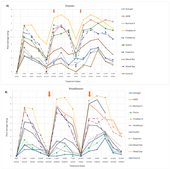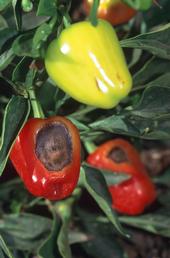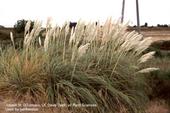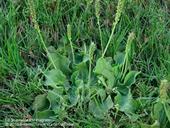- Author: Karey Windbiel-Rojas

Weed management in landscaped areas can be challenging. Weeds may need to be controlled for public safety, fire reduction, aesthetics, and elimination of harborage for other pests. While many nonchemical options for controlling weeds exist—such as physical removal with tools, steam, flame or steam devices, grazing animals, and others—there are some situations that may require the application of herbicides.
For decades, glyphosate has been a common active ingredient used to control weeds in both agricultural and nonagricultural settings. However, there has been significant public concern about the use of glyphosate and other herbicides due to their potential...
- Posted by: Lauren Fordyce
- Author: Belinda J. Messenger-Sikes

Abiotic plant disorders are generally caused by environmental conditions, rather than microorganisms. They are sometimes called noninfectious diseases. Abiotic disorders can develop if a plant's needs are not being met. Abiotic disorders can not only damage a plant directly but could predispose trees and shrubs to attack by insects and pathogens. Disorders and pests often act in combination, such as when drought stress or root injuries make trees susceptible to bark beetles and root decay pathogens.
Common causes of abiotic disorders include too much or not enough water, compacted soil, nutrient deficiency (often caused by imbalanced soil pH), excess soil...
![Leaves of a river red gum eucalyptus tree covered with redgum lerp psyllids. The white growths are the “lerp” produced by the immature (nymph) stage of the insect. [Credit: Jack Kelly Clark]](https://ucanr.edu/blogs/UCIPMurbanpests/blogfiles/92910small.jpg)
If you have eucalyptus trees, you might have noticed white, crusty growth on the leaves. Or maybe you saw a sticky, blackened mess of fallen leaves under a eucalyptus tree. These are signs of the redgum lerp psyllid, one of the most common psyllid pests that damages eucalyptus trees in California.
The adult psyllid is very small and as nymphs, they are concealed under a waxy cap, or lerp. As they feed, they excrete honeydew which can lead to the growth of black sooty mold, the source of those sticky leaves under the tree.
Although under biological control in coastal areas, this pest is still a problem under some growing conditions and on specific Eucalyptus species. Cultural practices to manage...
- Author: Belinda J. Messenger-Sikes
- Editor: Karey Windbiel-Rojas

Pampasgrass and jubatagrass facts
Pampasgrass (Cortaderia selloana) is a common ornamental landscape plant that readily naturalizes throughout California's coastal areas and some interior...
- Author: Karey Windbiel-Rojas

Looking for ways to manage weeds in your lawn or landscape? Join us on July 21, 2022 at noon for UC IPM's free monthly webinar to learn about how to control weeds using mostly nonchemical methods. We will discuss why weed identification is important, ways to prevent weed growth, and combining various methods for managing weed problems.
The webinar will be presented by Karey Windbiel-Rojas, Area Urban IPM Advisor and Associate Director for Urban & Community IPM with the UC Statewide IPM Program. Register today to serve your spot!
As always, the webinar will be recorded and...


